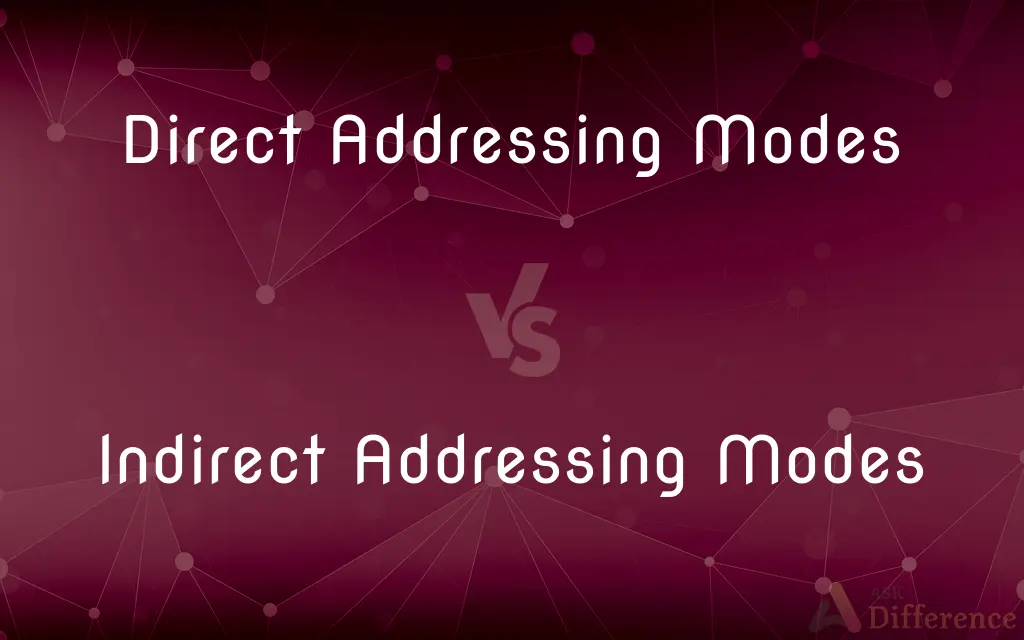Direct Addressing Modes vs. Indirect Addressing Modes — What's the Difference?
By Tayyaba Rehman — Published on January 8, 2024
Direct Addressing Modes refer to using the specific, exact memory address or a clearly identified entity in instructions. Indirect Addressing Modes involve referencing a memory address or entity indirectly, often through a pointer or a register.

Difference Between Direct Addressing Modes and Indirect Addressing Modes
Table of Contents
ADVERTISEMENT
Key Differences
Direct Addressing Modes specify the exact location or entity to be accessed directly in the instruction itself. This method is straightforward and quick, as the address or entity is explicitly stated. In contrast, Indirect Addressing Modes use a reference, like a register or a pointer, to determine the location or entity. This method adds a level of abstraction, making it more flexible but potentially slower due to the extra step of resolving the reference.
With Direct Addressing Modes, the instruction size can be larger, as it needs to contain the complete address or explicit reference. This mode is often used for operations where the target is known and fixed. On the other hand, Indirect Addressing Modes allow for more compact instructions, as they require only a reference or a pointer, not the full address. This mode is beneficial in scenarios where the target address or entity may vary or is determined dynamically.
Direct Addressing Modes offer simplicity and are easier to understand and implement, as they directly point to the required data or entity. However, this can limit flexibility and scalability in certain programming or hardware scenarios. In contrast, Indirect Addressing Modes provide greater flexibility and are essential for complex data structures, such as linked lists or dynamic memory allocation, where the direct address is not known in advance or can change.
In terms of security and error handling, Direct Addressing Modes can be more predictable and easier to debug, as the addresses and entities are explicitly stated. However, this can also make programs more vulnerable to certain types of attacks, like buffer overflows. Indirect Addressing Modes offer more complexity, which can be a double-edged sword: it can enhance security through obscurity but also make debugging and error detection more challenging.
Finally, Direct Addressing Modes are well-suited for applications with static memory allocation and fixed routines, such as embedded systems or simple software tasks. Indirect Addressing Modes are preferred in dynamic, complex applications like operating systems, where memory addresses and data structures are often dynamic and require the flexibility offered by indirect references.
ADVERTISEMENT
Comparison Chart
Address Specification
Specifies the exact address or entity directly in the instruction.
Uses a reference, such as a register or pointer, to indicate address.
Instruction Size
Larger, as it contains the full address or explicit reference.
Smaller, requiring only a reference or pointer.
Flexibility
Limited, best for fixed and known targets.
High, suitable for dynamic and changing targets.
Ease of Understanding
Simple and straightforward to understand and implement.
More complex due to the abstraction of references.
Application Suitability
Ideal for static, simple tasks with fixed memory allocation.
Better for dynamic, complex tasks with variable memory allocation.
Compare with Definitions
Direct Addressing Modes
Directly addressing a specific, known entity or memory location.
Access the data at address 0x004F directly.
Indirect Addressing Modes
Using pointers or registers to refer to addresses indirectly.
The value is loaded from the memory address that register R2 indirectly points to.
Direct Addressing Modes
Utilizing explicit, unambiguous references in instructions.
The instruction directly calls the function located at address 0x3A2B.
Indirect Addressing Modes
A method where the target is addressed through an intermediary.
Jump to the address indirectly specified by the value in register R3.
Direct Addressing Modes
Referring to an entity or location in a direct, straightforward manner.
Modify the variable directly addressed at 0x2AB3.
Indirect Addressing Modes
Accessing an entity or memory location through a reference or pointer.
Read the data from the location pointed by register R1.
Direct Addressing Modes
Instructions containing the exact address or entity for action.
Load the value from the directly specified memory address 0x1A3C.
Indirect Addressing Modes
Instructions utilizing indirect references for data manipulation.
Store the result in the memory location indirectly referred by the pointer.
Direct Addressing Modes
A method where the target's address or identifier is explicitly mentioned.
Store the number 5 at the directly addressed location 0x00F4.
Indirect Addressing Modes
Referencing a target location or entity indirectly for operations.
Increment the data at the location that is indirectly addressed through R4.
Common Curiosities
What are the benefits of Indirect Addressing Mode?
Offers flexibility and is suitable for dynamic, changing memory or data structures.
What is Direct Addressing Mode?
It's a method where instructions directly specify the memory address or entity.
Are there any downsides to Direct Addressing Mode?
Limited flexibility and potential vulnerability to certain attacks.
Why is Indirect Addressing Mode complex?
Due to the abstraction and additional resolving step for references.
When is Direct Addressing Mode preferred?
In scenarios with fixed, known memory locations or entities.
Does Indirect Addressing Mode offer better scalability?
Yes, it's better suited for scalable, dynamic applications.
How does Indirect Addressing Mode aid in complex programming?
By allowing flexible, dynamic referencing and memory management.
How does instruction size differ between the two modes?
Direct Mode often has larger instructions; Indirect Mode's are typically smaller.
What is Indirect Addressing Mode?
It involves accessing memory or entities through pointers or references, not directly.
Is Direct Addressing Mode easier to implement?
Yes, due to its straightforward, explicit nature.
Are both addressing modes used in modern computing?
Yes, each has its applications depending on the programming needs and system architecture.
Can Indirect Addressing Mode be more secure?
Potentially, due to its complexity and less predictable referencing.
Can Direct Addressing Mode lead to errors?
Yes, especially if the direct address is incorrect or misused.
In what situations is Direct Addressing Mode not suitable?
In applications requiring dynamic memory allocation or variable data structures.
Is debugging easier in Direct or Indirect Addressing Mode?
Generally easier in Direct Mode due to explicitness.
Share Your Discovery

Previous Comparison
Self-Pollination vs. Cross-Pollination
Next Comparison
Magnetic Flux vs. Magnetic Flux DensityAuthor Spotlight
Written by
Tayyaba RehmanTayyaba Rehman is a distinguished writer, currently serving as a primary contributor to askdifference.com. As a researcher in semantics and etymology, Tayyaba's passion for the complexity of languages and their distinctions has found a perfect home on the platform. Tayyaba delves into the intricacies of language, distinguishing between commonly confused words and phrases, thereby providing clarity for readers worldwide.













































